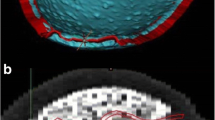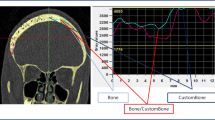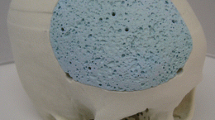Abstract
Background
CustomBone Service (CBS) is a patient-specific, biocompatible, and osteoconductive device made of porous hydroxyapatite, indicated for cranial reconstruction in adults and children. Adult literature data report a failure rate of about 8%. The aim of this Post-Marketing Surveillance study is to verify the hypothesis that CBS in children aged 7–13 years old shows a failure rate not superior to adults.
Materials and methods
Inclusion criteria were age at implantation ranging 7–13 years old, with at least 1 year elapsed from the date of surgery. The degree of satisfaction of surgeons and patients was assessed.
Results
Data about 76 implants in 67 patients (M:F = 41:26) were obtained from 28 centers across 7 European countries. The mean age at surgery was 10.03 ± 1.72 years, with age stratification almost equally distributed. Fifty-nine subjects received one CBS, 7 subjects two and one subject received three CBS. Main etiologies were trauma (60.5%), malformation (11.8%), bone tumor (10.5%), and cerebral tumor (7.9%). Main indications to CBS were decompression (47.4%), autologous bone resorption (18.4%), tumor resection (11.8%), malformation (9.2%), comminuted fracture (5.3%), and other materials rejection (5.3%). Main implantation sites were fronto-parieto-temporal (26.3%), parietal (23.7%), frontal (11.8%), fronto-temporal (10.5%), and parieto-temporal (7.9%). CBS was chosen as first line of treatment in 63.1% of the cases. Mean follow-up was about 36 months. Eleven adverse events (14.5%) were reported in nine devices. Five CBS required explantation (three cases of infection, one fracture, and one mobilization). Failure rate was 6.58%, which is statistically not superior to the explantation rate recorded in adults (two-sided 95%, CI 2.2–14.7%). Satisfaction of surgeons and patients was of about 95%.
Conclusion
CBS is a safe and effective solution for cranial repair in pediatric patients. In particular, over the age of 7, CBS shows a rate of failure as low as in adults.

Similar content being viewed by others
References
Lindner D, Schlothofer-Schumann K, Kern B-C, Marx O, Müns A, Meixensberger J (2016) Cranioplasty using custom-made hydroxyapatite versus titanium: a randomized clinical trial. J Neurosurg 126:1–9. https://doi.org/10.3171/2015.10.JNS151245
Iaccarino C, Viaroli E, Fricia M, Serchi E, Poli T, Servadei F (2015) Preliminary results of a prospective study on methods of cranial reconstruction. J Oral Maxillofac Surg Off J Am Assoc Oral Maxillofac Surg 73:2375–2378. https://doi.org/10.1016/j.joms.2015.07.008
Staffa G, Barbanera A, Faiola A, Fricia M, Limoni P, Mottaran R, Zanotti B, Stefini R (2012) Custom made bioceramic implants in complex and large cranial reconstruction: a two-year follow-up. J Cranio-Maxillo-fac Surg Off Publ Eur Assoc Cranio-Maxillo-fac Surg 40:e65–e70. https://doi.org/10.1016/j.jcms.2011.04.014
Frassanito P, Tamburrini G, Massimi L, di Rocco C, Nataloni A, Fabbri G, Caldarelli M (2015) Post-marketing surveillance of CustomBone Service implanted in children under 7 years old. Acta Neurochir 157:115–121. https://doi.org/10.1007/s00701-014-2254-y
Beuriat P-A, Szathmari A, Grassiot B, di Rocco F, Mottolese C (2016) Why a hydroxyapatite cranioplasty can be used to repair a cranial bone defect in children: experience of 19 cases. Neurochirurgie 62:251–257. https://doi.org/10.1016/j.neuchi.2016.04.003
Zaccaria L, Tharakan SJ, Altermatt S (2016) Hydroxyapatite ceramic implants for cranioplasty in children: a single-center experience. Childs Nerv Syst ChNS Off J Int Soc Pediatr Neurosurg 33:343–348. https://doi.org/10.1007/s00381-016-3327-4
Hardy H, Tollard E, Derrey S, Delcampe P, Péron JM, Fréger P, Proust F (2012) Clinical and ossification outcome of custom-made hydroxyapatite prothese for large skull defect. Neurochirurgie 58:25–29. https://doi.org/10.1016/j.neuchi.2011.09.006
Stefini R, Esposito G, Zanotti B, Iaccarino C, Fontanella MM, Servadei F (2013) Use of “custom made” porous hydroxyapatite implants for cranioplasty: postoperative analysis of complications in 1549 patients. Surg Neurol Int 4:12. https://doi.org/10.4103/2152-7806.106290
Bowers CA, Riva-Cambrin J, Hertzler DA, Walker ML (2013) Risk factors and rates of bone flap resorption in pediatric patients after decompressive craniectomy for traumatic brain injury. J Neurosurg Pediatr 11:526–532. https://doi.org/10.3171/2013.1.PEDS12483
Grant GA, Jolley M, Ellenbogen RG, Roberts TS, Gruss JR, Loeser JD (2004) Failure of autologous bone—assisted cranioplasty following decompressive craniectomy in children and adolescents. J Neurosurg Pediatr 100:163–168. https://doi.org/10.3171/ped.2004.100.2.0163
Josan VA, Sgouros S, Walsh AR, Dover MS, Nishikawa H, Hockley AD (2005) Cranioplasty in children. Childs Nerv Syst ChNS Off J Int Soc Pediatr Neurosurg 21:200–204. https://doi.org/10.1007/s00381-004-1068-2
Martin KD, Franz B, Kirsch M, Polanski W, von der Hagen M, Schackert G, Sobottka SB (2014) Autologous bone flap cranioplasty following decompressive craniectomy is combined with a high complication rate in pediatric traumatic brain injury patients. Acta Neurochir 156:813–824. https://doi.org/10.1007/s00701-014-2021-0
Piedra MP, Thompson EM, Selden NR, Ragel BT, Guillaume DJ (2012) Optimal timing of autologous cranioplasty after decompressive craniectomy in children. J Neurosurg Pediatr 10:268–272. https://doi.org/10.3171/2012.6.PEDS1268
Kabbani H, Raghuveer TS (2004) Craniosynostosis. Am Fam Physician 69:2863–2870
Morice A, Kolb F, Picard A, Kadlub N, Puget S (2017) Reconstruction of a large calvarial traumatic defect using a custom-made porous hydroxyapatite implant covered by a free latissimus dorsi muscle flap in an 11-year-old patient. J Neurosurg Pediatr 19:51–55. https://doi.org/10.3171/2016.8.PEDS1653
Frassanito P, Tamburrini G, Massimi L, Peraio S, Caldarelli M, di Rocco C (2017) Problems of reconstructive cranioplasty after traumatic brain injury in children. Childs Nerv Syst ChNS Off J Int SocPediatr Neurosurg 33:1759–1768. https://doi.org/10.1007/s00381-017-3541-8
Frassanito P, Massimi L, Caldarelli M, Tamburrini G, di Rocco C (2014) Bone flap resorption in infants. J Neurosurg Pediatr 13:243–244. https://doi.org/10.3171/2013.6.PEDS13312
Frassanito P, Massimi L, Caldarelli M, Tamburrini G, di Rocco C (2012) Complications of delayed cranial repair after decompressive craniectomy in children less than 1 year old. Acta Neurochir 154:927–933. https://doi.org/10.1007/s00701-011-1253-5
Jaberi J, Gambrell K, Tiwana P, Madden C, Finn R (2013) Long-term clinical outcome analysis of poly-methyl-methacrylate cranioplasty for large skull defects. J Oral Maxillofac Surg Off J Am Assoc Oral Maxillofac Surg 71:e81–e88. https://doi.org/10.1016/j.joms.2012.09.023
Lam S, Kuether J, Fong A, Reid R (2015) Cranioplasty for large-sized calvarial defects in the pediatric population: a review. Craniomaxillofacial Trauma Reconstr 8:159–170. https://doi.org/10.1055/s-0034-1395880
Lee S-C, Wu C-T, Lee S-T, Chen P-J (2009) Cranioplasty using polymethyl methacrylate prostheses. J Clin Neurosci Off J Neurosurg Soc Australas 16:56–63. https://doi.org/10.1016/j.jocn.2008.04.001
Iaccarino C, Mattogno PP, Zanotti B, et al (2016) Septic complication following porous hydroxyapatite cranioplasty: prosthesis retention management. J Neurosurg Sci
Wehrli LA, Zweifel N, Weil R, Altermatt S (2012) Juvenile psammomatoid ossifying fibroma of the forehead, radical resection, and defect coverage with a hydroxyl-apatite composite-a case report. Eur J Pediatr Surg Off J Austrian Assoc Pediatr Surg Al Z Für Kinderchir 22:479–484. https://doi.org/10.1055/s-0032-1313349
F-C Faenza, Data on file, pending publication
Author information
Authors and Affiliations
Corresponding author
Ethics declarations
Conflict of interest
Paolo Frassanito received a grant from Fin-ceramica Faenza S.p.A.
Angelo Nataloni and Valentina Canella are fully employed at Fin-Ceramica Faenza S.p.A.
No competing financial interests exist for the remaining authors.
Rights and permissions
About this article
Cite this article
Frassanito, P., Massimi, L., Tamburrini, G. et al. Custom-made hydroxyapatite for cranial repair in a specific pediatric age group (7–13 years old): a multicenter post-marketing surveillance study. Childs Nerv Syst 34, 2283–2289 (2018). https://doi.org/10.1007/s00381-018-3905-8
Received:
Accepted:
Published:
Issue Date:
DOI: https://doi.org/10.1007/s00381-018-3905-8




